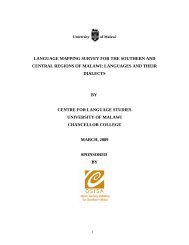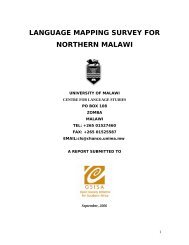SOCIOLOLINGUISTIC SURVEYS - Centre for Language Studies
SOCIOLOLINGUISTIC SURVEYS - Centre for Language Studies
SOCIOLOLINGUISTIC SURVEYS - Centre for Language Studies
You also want an ePaper? Increase the reach of your titles
YUMPU automatically turns print PDFs into web optimized ePapers that Google loves.
live near schools where they teach, it was difficult to get teachers. The population,<br />
there<strong>for</strong>e, does not feature as many teachers as the researchers would have liked.<br />
The areaspecific problem experienced in Nsanje and Chikwawa was the alarmingly high<br />
temperatures. These high temperatures induced fatigue in the researchers who were not<br />
used to hot climate conditions.<br />
The third problem had to do with the politics of the area in which the survey was<br />
conducted. Nsanje and Chikwawwa districts have all their parliamentary constitutients<br />
(except one) taken by the ruling UDF party. The single seat in the hands of the<br />
opposition belongs to the leader of the opposition, who also happens to be the President<br />
of the Malawi Congress Party (MCP). In these two districts, there is political tension<br />
between the two rival parties. In some cases this tension does lead to violence. The<br />
research team was on more than one occasion mistakenly identified as an MCP group.<br />
The mistaken identity was due to the fact that the lowly educated local people could not<br />
tell the difference between the MCP flag and the GTZ/Malawi logo which was on all the<br />
vehicles the research team used. To the local people, the flags resembled the old Malawi<br />
Congress Party flag. As a result, it used to take the research team some time to educate<br />
the local UDF faithfuls about the research teams’ noninvlovemement in MCP or political<br />
issues as awhole. Such problems were met at Tengani and Marka.<br />
Due to the problems mentioned above, it was impossible to reach the target of<br />
interviewing 1000 respondents. Instead 817 subjects were interviewed.<br />
6.4.6 SOME DEMOGRAPHIC CHARACTERISTICS OF THE RESPONDENTS<br />
Areas of interest here are sex, age, and levels of education of the categories of the<br />
respondents. Of the 817 respondents, 289(35.4%) were parents/guardians; 16 (2.0%)<br />
were teachers; 409 (50.1%) were pupils, whilst 103 (12.6%) were in the ‘other’ category.<br />
The distribution of the respondents per district was as follows: 328 respondents (40.1%)<br />
<strong>for</strong> Chikwawa and 489 respondents (59.9%) <strong>for</strong> Nsanje. In terms of age, the age range<br />
1519 years constituted the larget group with 222 respondents (27.2%); followed by the<br />
1014 years age group with 190 respondents (23.3%). Table 80 captures the age<br />
statistics.<br />
92





